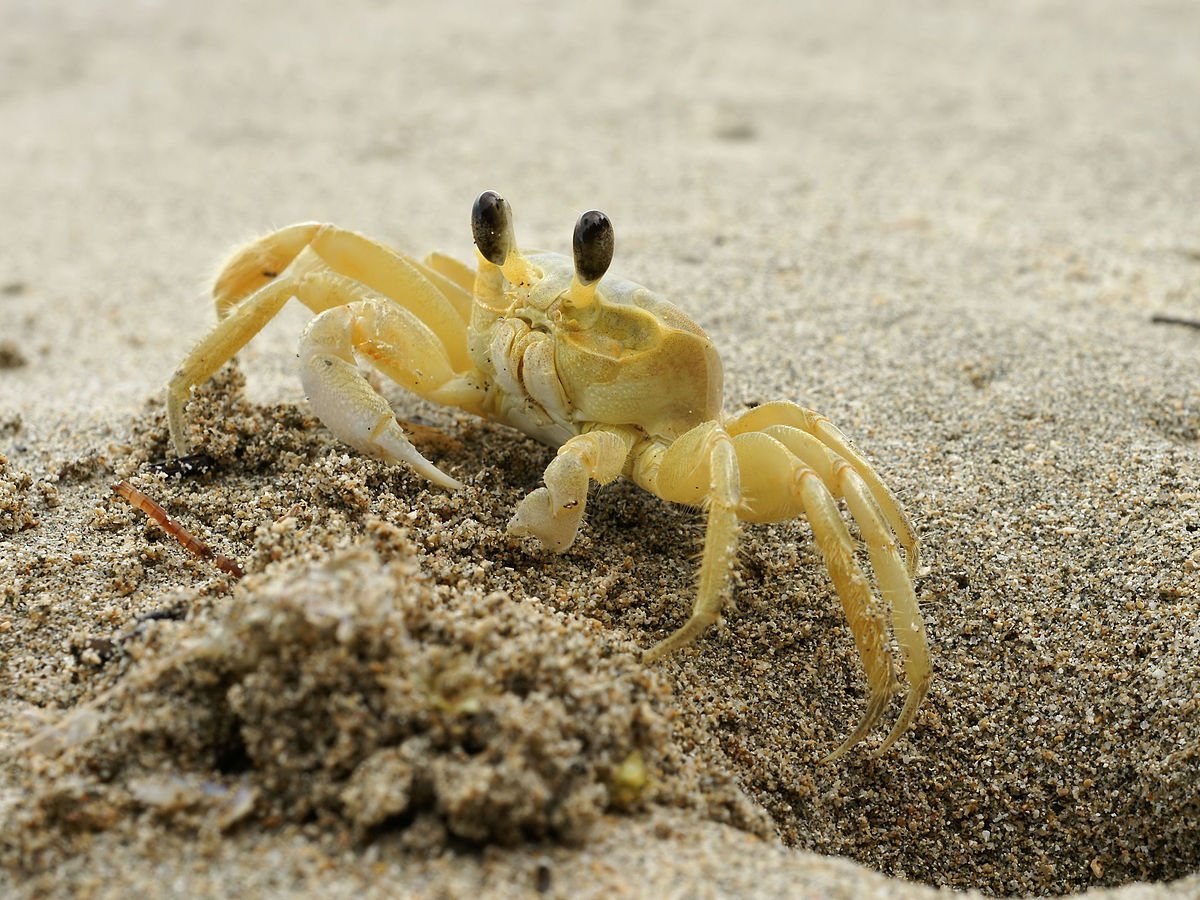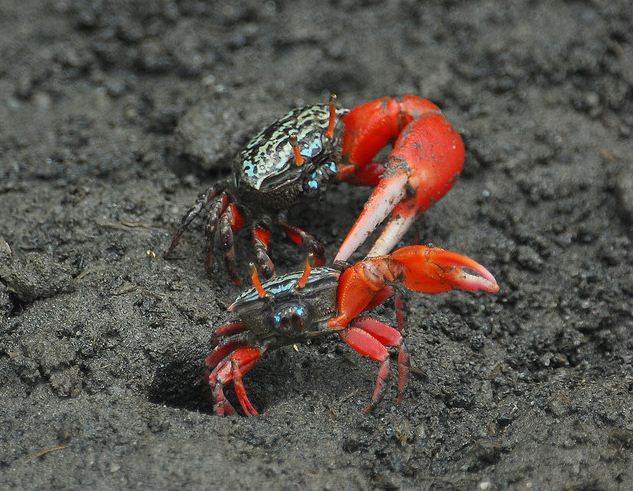Crabs are an underappreciated species. Whilst living in a harsh and arid environment they dedicate their lives to keeping the beach pristine.
The Maldives is rich in life and biodiversity, but the majority of this diversity is marine based. Due to the great distance of the Maldives from large land masses there are relatively few land based species. Crabs, are one of the most common. These shy little critters are abundant, entertaining to observe and vital to the island’s survival.

Land Hermit Crabs
Land hermit crabs are completely adapted to life on land, living under leaf litter or in other sheltered areas. A common error made by people is completely submerging these crabs in water, mistaking them for marine animals. Unfortunately hermit crabs can only survive for a few minutes when completely submerged. They are not true crabs because they do not have their own shell. Instead they use shells from dead gastropods in order to protect their soft abdomens. They are a long lived species – sometimes reaching the age of 40 years and older – so they go through a lot of shells!
Hermit crabs start their lives moving through a variety of larval stages whilst floating in the ocean. The larvae spend the first 40 – 60 days of their life alongside plankton until they change into a hermit crab/lobster shape. In this final larval stage they find a small shell and over the period of a month will spend more time on land until they finally molt and leave the ocean for good. By feeding on vegetation, insects, detritus, other smaller hermit crabs and microbes in the sand the crab grows in size. To accommodate this growth their hard exoskeleton must be shed periodically during the year and this process will carry on through-out the hermit crab’s life. As they grow in size the hermit crab molts less frequently and the molt process takes longer, during which time the crab will stay completely submerged in the sand.
When sexually mature the male will knock on the female’s shell to signal mating. Both genders will then extend out of their shells and the male will fertilise the female. After fertilisation the female will carry her eggs around on her abdomen where they are protected from predation. The bigger the female the larger the quantity of eggs. After one month the eggs are fully developed and the colour of the egg will have changed from brick red to grey. To hatch the eggs the female will enter the water at low tide. Upon contact with water the eggs burst open and the larvae are released.

Ghost Crab
Another common crab species is the ghost crab which is aptly named due to its nocturnal activity and sandy colouration, making the crab perfectly camouflaged into the beach backdrop. These crabs are found on sandy beaches and live in burrows. The narrower and shorter the burrow the smaller the crab. Their burrows serve a number of purposes: protection from predation, storage of their food, protection from drying out and other extreme weather conditions as well as a place to mate (although not all ghost crabs mate in burrows).
Young crabs and female crabs create burrows with sand scattered everywhere, with young crabs preferring to create burrows nearer to the water, whilst male crabs have burrows with a neat mound of sand outside – the larger the crab the larger the mound. Males produce mating sounds, squeaking noises, in a variety of ways; by rubbing their right claw on their leg, by rubbing their legs together, or by using their gill chambers, which they keep moist with saltwater.
After mating the females store thousands of eggs inside an abdominal flap. She will then venture into the sea when the eggs are ready to hatch. Since ghost crabs cannot swim the female will float upside down in the water allowing the eggs in her abdomen to breathe. Upon contact with saltwater the larvae are released and after two months return to land.
The exoskeleton of a ghost crab is water tight, which prevents the crab from drying out in the arid and salty conditions on the beach. All ghost crabs have eye stalks with the males additionally having horns. These eyestalks enable the crab to see in any direction and can be stored in groves on their shells. The ghost crab’s eye sight is so good that they are able to catch insects’ mid-flight. They also have a well-developed sense of smell. They are very agile, capable of moving at 10mph, which makes them the fastest of all crustaceans.
Due to the erratic nature of their food supply ghost crabs are very protective of their food and will use their claws in combat displays. Male ghost crabs have one claw that is slightly larger than the other and combat is normally non-contact and ritualistic. Ghost crabs spend the majority of their day looking for food and particularly like to eat fish, seaweed, microbes in the sand, jellyfish, other crabs, snails, turtle hatchings and really anything they can get their claws on.

Swift-Footed Rock Crab
The swift-footed rock crab can easily go unnoticed due to its elusive behaviour. It inhabits rocky shores at mid to high tide level and so can be found around beach rocks, boat ramps, rock walls and jetties. These crabs are fast moving and are generally only seen at night, unless disturbed. Then you may observe them jumping from rock to rock trying to find a new refuge.
Their colouration can be mesmerising with a multitude of blue, green, purple, orange, white and black. The crabs encountered on Gili are more blue, green and purple with white stripes. The shell (carapace) can be up to eight centimeters wide and is flattened, compared to other crabs which have shells that are more rounded.
The crab feeds on algae, detritus, small vertebrates, barnacles, limpets and snails. They use their claws to break into the shells of other animals and to tear off pieces of their prey to be transferred into their mouth. This species is predated upon by a variety of animals including birds, octopus and fish, so it isn’t safe for them in the ocean or out of it!

Fiddler Crabs
Fiddler crabs are a small and short lived species of crab (up to two years) and are closely related to ghost crabs. They are found in mangroves, brackish water, mud flats, lagoons and swamps. The colouration of the crabs change in correlation with circadian rhythm – during the day they are dark and at night they are light.
Fiddler crabs are well known for their sexual dimorphism – the male’s major claw is much larger than the females. If the large claw has been lost the male will develop a new large claw on the opposite side, which will appear after molting. The female’s claws are the same size. The crabs use their claws in communication, courtship and combat. The male claw is used in waving displays which signals to the female that they are ready to mate. A more vigorous waving display indicates a healthier male and a larger claw indicates a wider burrow which will provide better temperatures for egg incubation.
Females chose their partners based on claw size and the quality of waving. Once a female has been attracted she will reside in the male’s burrow whilst the eggs are being laid. The female will carry her eggs on the underside of her body for a two week gestation period. After this period the female will venture out of the burrow and release the larvae into a receding tide.
During feeding the crabs move their smaller claw from the ground to their mouth. This movement looks like the crab is playing the smaller claw like a fiddle – hence the name, fiddler crab. The smaller claw is used to pick up the sediment which is then sifted through in the crab’s mouth. Algae, microbes and fungus are the preferred diet of the crab. After the nutrients are extracted the sediment is placed back onto the ground in a ball. The feeding habits may play a vital role in preserving the ecosystem as they aerate the soil. The fiddler crab can be seen when visiting local islands, especially in the mangrove area at low tide.